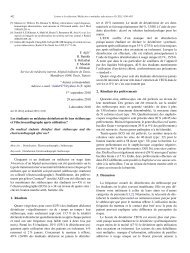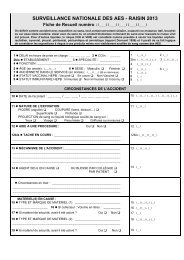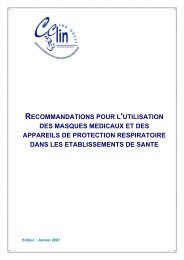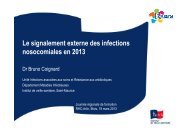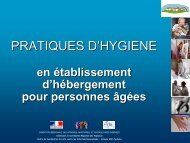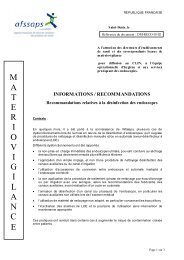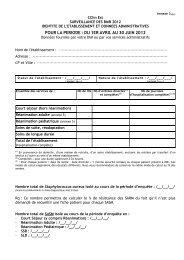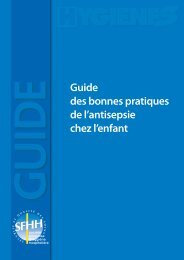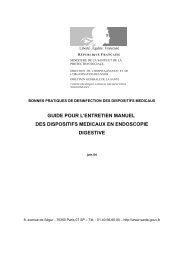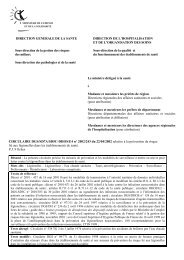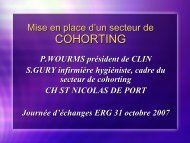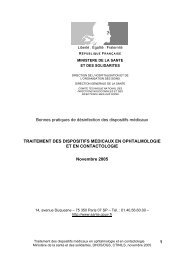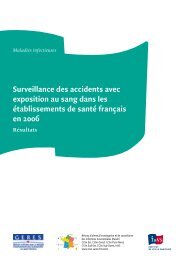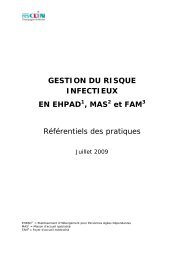Surveillance des accidents avec exposition au sang dans les ...
Surveillance des accidents avec exposition au sang dans les ...
Surveillance des accidents avec exposition au sang dans les ...
Create successful ePaper yourself
Turn your PDF publications into a flip-book with our unique Google optimized e-Paper software.
Maladies infectieuses<br />
Novembre 2009<br />
<strong>Surveillance</strong> <strong>des</strong> <strong>accidents</strong> <strong>avec</strong> <strong>exposition</strong> <strong>au</strong> <strong>sang</strong> <strong>dans</strong> <strong>les</strong> établissements<br />
de santé français en 2007 – Résultats<br />
Sous l’égide du Rése<strong>au</strong> d’alerte, d’investigation et de surveillance <strong>des</strong> infections nosocomia<strong>les</strong> (Raisin) et <strong>avec</strong> le Groupe d’étude sur le risque d’<strong>exposition</strong><br />
<strong>des</strong> soignants <strong>au</strong>x agents infectieux (Geres), <strong>les</strong> métho<strong>des</strong> de surveillance <strong>des</strong> <strong>accidents</strong> exposant <strong>au</strong> <strong>sang</strong> (AES) font l’objet d’un consensus et d’un rése<strong>au</strong><br />
national depuis 2002.<br />
Chaque établissement documentait de manière volontaire, anonyme et standardisée tout AES chez un membre du personnel (étudiant ou stagiaire inclus) déclaré<br />
<strong>au</strong> médecin du travail du 1 er janvier <strong>au</strong> 31 décembre 2007. Les données étaient recueillies sur une fiche adaptée du Geres documentant <strong>les</strong> circonstances de<br />
l’AES (nature, mécanisme, matériel en c<strong>au</strong>se), son suivi (soins immédiats, suivi et prophylaxie éventuelle) et le statut infectieux du patient source. L’incidence<br />
<strong>des</strong> AES était rapportée <strong>au</strong> nombre de lits d’hospitalisation, <strong>au</strong>x nombres d’Équivalents temps plein (ETP) de professionnels et à la consommation de certains<br />
dispositifs médic<strong>au</strong>x.<br />
En 2007, 15 605 <strong>accidents</strong> d’<strong>exposition</strong> <strong>au</strong> <strong>sang</strong> étaient recensés <strong>dans</strong> 626 établissements. La couverture nationale du rése<strong>au</strong> peut être estimée à 22 % <strong>des</strong><br />
établissements de santé et 46 % <strong>des</strong> lits soit un élargissement de l’implantation par rapport à 2006 (respectivement 18 % et 42 %). La connaissance du statut<br />
du patient source vis à vis du VHC et du VIH, qui conditionne la prise en charge ultérieure du soignant, demeure encore <strong>dans</strong> plus de 20 % <strong>des</strong> cas inconnue.<br />
Le t<strong>au</strong>x de prescription de la chimioprophylaxie antirétrovirale continue de décroître, puisque prescrite <strong>dans</strong> 4 % <strong>des</strong> AES en 2007 versus 6,3 en 2002. Le traitement<br />
a été interrompu <strong>dans</strong> 41 % <strong>des</strong> cas le plus souvent en raison de la connaissance a posteriori du statut négatif du patient source pour le VIH. Le délai médian<br />
de prise en charge d’un soignant après son AES était d’une heure, démontrant le caractère très opérationnel de cette organisation en France.<br />
Depuis 2004 <strong>les</strong> aiguil<strong>les</strong> à suture arrivent en première position <strong>des</strong> AES liés à <strong>des</strong> aiguil<strong>les</strong>, avant <strong>les</strong> sous cutanées. Ces AES représentent 10 % de l’ensemble<br />
<strong>des</strong> <strong>accidents</strong> survenant <strong>dans</strong> <strong>les</strong> secteurs de chirurgie, d’obstétrique mais <strong>au</strong>ssi de réanimation et d’urgence. Il paraît donc toujours nécessaire de favoriser<br />
la sécurisation de ce geste et de promouvoir l’usage d’aiguil<strong>les</strong> à bout mousse.<br />
L’observance du port du gant chez <strong>les</strong> soignants accidentés et la proximité du collecteur sont passées respectivement de 58 à 67 % et de 66 à 72 % entre 2002<br />
et 2007 ce qui représente encore un nombre élevé de situations à risque. Même s’il progresse, le t<strong>au</strong>x de sécurisation du matériel demeure encore faible <strong>dans</strong><br />
<strong>les</strong> AES documentés <strong>avec</strong> 31 % pour <strong>les</strong> cathéters courts et 32 % pour <strong>les</strong> aiguil<strong>les</strong> <strong>des</strong> chambres implantab<strong>les</strong> contre respectivement 26 et 24 % en 2005.<br />
L’incidence <strong>des</strong> AES pour 100 lits d’hospitalisation est de 7,5. Sur la base <strong>des</strong> 448505 lits d’hospitalisation recensés en France (données SAE 2006) cela<br />
permet d’estimer à 33 638 (IC à 95 % : 33 293-33 983) le nombre d’AES qui <strong>au</strong>raient été déclarés en 2007 <strong>au</strong>x médecins du travail <strong>des</strong> établissements de santé<br />
français. Si on met ce chiffre en perspective <strong>avec</strong> <strong>les</strong> données 2004 du même rése<strong>au</strong>, à savoir une incidence de 8,9 % et un nombre d’AES estimé de 41429,<br />
cela représente une baisse de près de 8 000 AES. Même s’il ne s’agit que d’une estimation assez empirique cela laisse à penser que <strong>des</strong> progrès importants en<br />
terme de sécurité <strong>des</strong> soins ont été accomplis en France durant cette période. Poursuivre et accentuer cette dynamique sera l’objectif du programme national<br />
2009-2012 de prévention <strong>des</strong> infections nosocomia<strong>les</strong>. L’objectif annoncé de ce dernier est de réduire encore de 25 % l’incidence <strong>des</strong> AES.<br />
Mots clés : <strong>accidents</strong> d’<strong>exposition</strong> <strong>au</strong> <strong>sang</strong>, professionnel de santé, surveillance, prévention<br />
<strong>Surveillance</strong> of <strong>accidents</strong> involving exposure to blood in French health facilities in 2007 – Results<br />
<strong>Surveillance</strong> of occupational Blood and Body Fluids Exposures (BBFE) in France is standardised since 2002 and conducted at national level through<br />
the Nosocomial Infection Early Warning, Investigation and <strong>Surveillance</strong> Network (Rése<strong>au</strong> d’alerte, d’investigation et de surveillance <strong>des</strong> infections<br />
nosocomia<strong>les</strong> [Raisin]) in collaboration with Geres (Groupe d’étude sur le risque d’<strong>exposition</strong> <strong>des</strong> soignants <strong>au</strong>x agents infectieux). Participation of<br />
Healthcare Facilities (HCF) to this surveillance network (called AES-Raisin) is voluntary and anonymous.<br />
Each health facility documented BBFEs occurring from 1 January 2007 to 31 December 2007 using a standardised questionnaire adapted from Geres<br />
studies on a voluntary and anonymous basis. The questionnaire documented the nature, circumstances (mechanism, type of device, infectious status of<br />
the source) and follow-up of each BBFE. Incidence of BBFE is reported per 100 hospitalisation beds, number of health professionals’ Full Time Equivalent<br />
(FTE), and consumption of certain medical devices.<br />
In 2007, 15,605 BBFEs were documented in 626 participating healthcare facitilties(HCF), which accounted for 22% of HCFs and 46% of hospitalisation<br />
beds in France, in steady increase compared to 2006 (18% and 42% respectively), and making this surveillance network a broad one. HCV or HIV status<br />
of the source was not known for more than 20% of documented BBFEs.<br />
Post-exposure prophylaxis (PEP) decreased at 4% of exposed personnel (6.3% in 2002) and was discontinued in 41% mainly bec<strong>au</strong>se the source patient<br />
appeared secondary to be seronegative for HIV. The median time to support a caregiver after a BBFE was one hour, illustrating the highly operational<br />
nature of this organization in France.<br />
Since 2004, sutures were the most frequent c<strong>au</strong>se of BBFE associated with suture need<strong>les</strong> (more than subcutaneous injections) and accounted for 1,270<br />
(10%) of all BBFE occurred in surgery, obstetrics and in ICU or emergency rooms. Prevention through education and use of blunt suture need<strong>les</strong> is still<br />
a priority. Compliance to glove use increased from 58% in 2002 to 67% in 2007 as did the sharps disposal containers accessibility from 66% in 2004<br />
to 72% leaving however a huge number of at-risk behaviors. Although in progress, the proportion of safety devices remained low in 2005 with 31% for<br />
intravascular catheters and 32% for need<strong>les</strong> for implantable devices.<br />
BBFE overall incidence was 7.5 per 100 beds. Considering that all French hospitals account for 448,505 beds (SAE data for 2006), 33,628 (95%CI<br />
[33,293-33,983]) BBFEs could have occurred in France in 2007. Compared with the 2004 data from the same network (8.9% incidence and 41,429<br />
estimated reported BBFEs) we could estimate at nearly 8,000 the number of prevented <strong>accidents</strong>.<br />
Even though our estimate is rough, this result leads us to think that HCWs safety has been sharply increased during the past four years. Maintaining and strengthening<br />
this tendency is the challenge of the new French 2009-2012 Nosocomial Infection Prevention Program with a one fourth BBFE incidence reduction objective.<br />
Citation suggérée :<br />
Raisin. <strong>Surveillance</strong> <strong>des</strong> <strong>accidents</strong> <strong>avec</strong> <strong>exposition</strong> <strong>au</strong> <strong>sang</strong> <strong>dans</strong> <strong>les</strong> établissements de santé français en 2007 – Résultats. Saint-M<strong>au</strong>rice<br />
(Fra) : Institut de veille sanitaire, novembre 2009, 72 p. Disponible sur : www.invs.sante.fr<br />
01 40 37 95 00<br />
Institut de veille sanitaire<br />
12 rue du Val d’Osne<br />
94 415 Saint-M<strong>au</strong>rice Cedex France<br />
Tél. : 33 (0)1 41 79 67 00<br />
Fax : 33 (0)1 41 79 67 67<br />
www.invs.sante.fr<br />
ISSN : 1956-6956<br />
ISBN-NET : 978-2-11-098694-8<br />
Réalisé par Diadeis-Paris<br />
Dépôt légal : novembre 2009




